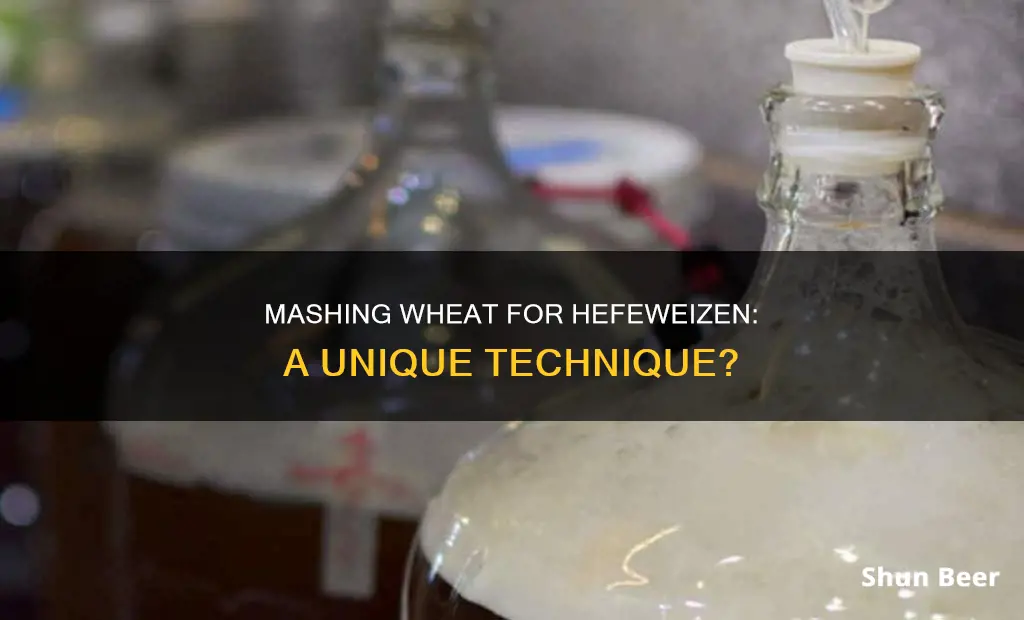
Hefeweizen, also known as Weissbier, is a traditional German wheat beer. It is typically brewed with at least 50% wheat malt, with the remaining grains being Pilsner malt or light Munich malt. The high percentage of wheat malt can lead to a stuck mash, so brewers often add rice hulls to the mash to prevent this issue. While a single-infusion mash at around 150°F (66°C) is sufficient, a traditional decoction mash or a step mash with a ferulic acid rest at 105-112°F (40-44°C) can enhance the malt profile and promote the development of the beer's signature clove character.
| Characteristics | Values |
|---|---|
| Grain bill | 60/40 split between wheat malt and pilsner malt |
| Rice hulls | At least 1/2 pound of rice hulls per 5 gallons |
| Hops | Minimal; very low to moderately low bitterness |
| Yeast | Non-flocculant strain that is POF+ (produces phenolic off-flavors) |
| Water profile | Use a reverse osmosis filtration system and build up the profile from scratch |
| Original Gravity | 1.044 – 1.053 |
| Final Gravity | 1.008 – 1.014 |
| Alcohol by Volume | 4.3% – 5.6% |
| Bitterness | 8 – 15 IBU |
| Color (SRM) | 2 – 6 |
What You'll Learn
- Hefeweizen is a traditional Bavarian wheat beer brewed with at least 50% wheat malt
- The hopping rate is very low, allowing the wheat and Pilsner malt's grainy, bready flavour to shine
- Hefeweizen yeast is POF+ (produces phenolic off-flavours) and is responsible for the beer's banana and clove flavours
- Fermentation temperature is important: a relatively cool fermentation around 17-18°C tends to produce the best results
- Hefeweizen is meant to be consumed young and can go from grain to glass in two weeks if kegged

Hefeweizen is a traditional Bavarian wheat beer brewed with at least 50% wheat malt
Hefeweizen is typically brewed with a 60/40 split of wheat malt and pilsner malt, respectively. The large proportion of wheat malt contributes a bready flavour and a soft, pillowy mouthfeel. The beer is also highly carbonated, which, along with the wheat's high protein content, creates a thick, fluffy head.
The yeast used in Hefeweizen is what really makes this style of beer stand out. Bavarian weissbier yeast strains produce powerful esters and phenols that give the beer its signature banana, clove, and bubblegum flavours. The beer is served unfiltered, with plenty of yeast in suspension, though German examples are often bottled with a lager strain.
Hefeweizen typically has a low to moderate alcohol content, ranging from 4.3% to 5.6% ABV. The hopping rate is very low, allowing the underlying grainy, bready flavours from the wheat and pilsner malt to come through. The bitterness level of Hefeweizen is typically around 15 IBUs, with very low to no hop flavours or aromas.
When it comes to mashing, a traditional decoction mash is often used for Hefeweizen, with rests in the mid to upper 140s °F (mid-60s °C) and the upper 150s to low 160s °F (low 70s °C). This can promote a more attenuative wort with enhanced malt character. An optional mash rest at 110 °F (43 °C) promotes the development of ferulic acid, which Hefeweizen yeast converts into 4-vinyl guaiacol, the compound responsible for the beer's signature clove character.
Hefeweizen is a delight for the senses and is considered one of the most recognisable and enjoyable beer styles in the world.
Bass Beer and Wheat: What's the Connection?
You may want to see also

The hopping rate is very low, allowing the wheat and Pilsner malt's grainy, bready flavour to shine
Hefeweizen is a traditional Bavarian wheat beer with a signature clove and banana character. It is made with at least 50% wheat malt, and the rest is Pilsner malt. The hopping rate is very low, which allows the underlying grainy, bready flavour from the wheat and Pilsner malt to shine.
The German Hefeweizen, or Weissbier, is a pale, refreshing German wheat beer. It is infamous for its fluffy mouthfeel and distinctive banana and clove flavours. The ingredients are straightforward, but the process is where most of the differences lie, mainly in mashing and fermentation.
The German Hefeweizen has a relatively simple grain bill, consisting of a 60/40 split between wheat malt and Pilsner malt, respectively. With such a high percentage of wheat malt, it is recommended to add rice hulls to enhance stability and reduce the risk of a stuck mash.
For the German Hefeweizen, minimal hops are added. It has a very low to moderately low bitterness with hardly any hop aroma. The hopping rate is very low, which allows the wheat and Pilsner malts' grainy, bready flavour to shine.
Developing a Hefeweizen recipe is straightforward, and it’s a lovely beginner style. Aim for an original gravity around 1.050 (12.3° P), or a couple of ticks on either side, using a grist of anywhere from 50 to 70 percent malted wheat. The remainder can be Pilsner malt. The mash can be as simple as a single infusion at 150° F (66° C), but a traditional decoction mash with rests in the mid to upper 140s °F (mid 60s °C) and the upper 150s to low 160s °F (low 70s °C) can promote a more attenuative wort with enhanced malt character.
Dos Equis Beer: Wheat or Not?
You may want to see also

Hefeweizen yeast is POF+ (produces phenolic off-flavours) and is responsible for the beer's banana and clove flavours
Hefeweizen is a Bavarian wheat beer, also known as weissbier or weizenbier. It is a light, refreshing beer with a distinctive banana and clove flavour. The banana and clove flavours are the result of the yeast strain used. Hefeweizen yeast is POF+ (produces phenolic off-flavours) and is responsible for the beer's unique flavour profile.
The yeast strain selected for Hefeweizen is critical, as it significantly impacts the beer's ester and phenol production. Brewers aim for a non-flocculant yeast strain that is POF+ to create the signature banana and clove notes. The intensity of phenols can vary depending on the chosen strain, so brewers must carefully consider their options.
The Weihenstephan Weizen (Wyeast 3068) strain is a popular choice, known for its balanced production of banana esters and clove phenols. This strain is temperature-sensitive, with increased temperatures and decreased pitch rates resulting in enhanced ester production. Conversely, overpitching can diminish the banana character.
Another option is the Hefeweizen Ale Yeast (WLP300) strain, which tends to favour banana flavours over clove. Additionally, the German Wheat (Wyeast 3333-PC) strain is highly flocculant and suitable for producing a clear Hefeweizen, known as Kristallweizen.
To enhance the banana flavour in Hefeweizen, brewers can experiment with different pitching rates and oxygen levels. Underpitching the yeast, for example, can increase fermentation characteristics and stress the yeast, potentially boosting ester formation and banana flavours. However, it is important to strike a balance, as underpitching too much can lead to sluggish fermentations and unwanted off-flavours.
The fermentation temperature also plays a crucial role in flavour development. A cooler fermentation temperature, around 62–64 °F (17–18 °C), tends to yield the best results. Additionally, open fermentation can increase phenol and ester production compared to conical fermentation.
In summary, Hefeweizen yeast is POF+ and plays a pivotal role in developing the beer's banana and clove flavours. Brewers must carefully select yeast strains, experiment with pitching rates and temperatures, and consider open fermentation to fine-tune the balance of flavours in this unique style of beer.
Purple Haze Mystery: Is It a Wheat Beer?
You may want to see also

Fermentation temperature is important: a relatively cool fermentation around 17-18°C tends to produce the best results
Hefeweizen is a German wheat beer, known for its fluffy mouthfeel and distinctive banana and clove flavours. The fermentation temperature plays a key role in the overall taste of the beer.
Fermenting at higher temperatures produces a stronger banana flavour. This is due to the increased production of isoamyl acetate (IA) ester. Warmer temperatures encourage the production of esters, and the warmer the fermentation, the more banana flavour is produced.
On the other hand, fermenting at lower temperatures, around 17-18°C, promotes the production of phenols, which create spicy clove flavours. This is due to the production of 4-vinyl guaiacol (4VG) phenol.
By controlling the fermentation temperature, brewers can choose to enhance either the banana or clove flavours in their beer. A balanced Hefeweizen is the goal, so the beer should not be overly phenolic or taste like banana only.
A relatively cool fermentation temperature of 17-18°C tends to produce the best results. This temperature range allows for a balance between the banana and clove flavours, creating a harmonious beer.
While the fermentation temperature is important, other factors also influence the final flavour profile of the beer. For example, the pitching rate, yeast strain, growth rate, and oxygen levels all play a significant role in the types and amounts of esters produced. Additionally, the quality of the malt or malt extract used is crucial, and a simple malt bill is often preferred.
The Hefeweizen style is forgiving, and brewers can experiment within a temperature range of 16-19°C to find their preferred flavour profile. However, a cool fermentation temperature is generally recommended to achieve the desired balance of flavours in this classic German wheat beer.
Leinenkugel Summer Shandy: A Wheat Beer for Summer?
You may want to see also

Hefeweizen is meant to be consumed young and can go from grain to glass in two weeks if kegged
Hefeweizen is a traditional Bavarian wheat beer that is meant to be consumed young. It can go from grain to glass in two weeks if kegged. The beer is brewed with at least 50% wheat malt, which gives it a bready flavour and a soft, pillowy mouthfeel. The hopping rate is very low, allowing the underlying grainy, bready flavour from the wheat and Pilsner malt to shine through. It is a light, refreshing, approachable beer with a hazy appearance and a soft texture.
The Hefeweizen style is characterised by its distinctive banana and clove flavours, which are produced by Bavarian weissbier yeast strains. These create powerful esters and phenols that give the beer its unique flavour profile. The beer is served unfiltered, with plenty of yeast in suspension, resulting in a thick, fluffy head.
When brewing Hefeweizen, it is important to use the right type of yeast to achieve the desired flavour profile. The fermentation temperature also plays a crucial role in the final flavour of the beer. A relatively cool fermentation temperature of around 62 to 64°F (17 to 18°C) tends to produce the best results.
The mash process for Hefeweizen can vary. A traditional decoction mash involves multiple rests at different temperature ranges to promote a more attenuative wort with enhanced malt character. An optional mash rest at 110°F (43°C) promotes the development of ferulic acid, which Hefeweizen yeast converts into 4-vinyl guaiacol, responsible for the style's signature clove character. However, a simpler single infusion mash at 150°F (66°C) is also effective.
Hefeweizen is typically bottled or kegged and enjoyed soon after brewing. It is a beer that is meant to be consumed fresh, as it can lose its desirable qualities over time. The carbonation level for bottled Hefeweizen should be around 3 to 3.5 volumes (6 to 7 g/L) of carbon dioxide to avoid bottle explosions.
Peroni Beer: Wheat-Based Brew or Not?
You may want to see also
Frequently asked questions
No, you do not need to use a different mash when making a Hefeweizen beer with wheat. A single-step infusion mash is the simplest method, and a traditional decoction mash or a step mash is also an option.
A decoction mash involves removing about 1/3 of the thick mash, heating it to 160°F for 10 minutes, boiling it for 15 minutes, and then reintroducing it to the mash tun to raise the overall temperature to the next step. A step mash, on the other hand, involves maintaining specific temperature ranges for certain periods of time.
A decoction mash or a step mash can promote a more attenuative wort with enhanced malt character. Additionally, an optional mash rest at 110°F (43°C) can be included in a decoction or step mash to promote the development of ferulic acid, which Hefeweizen yeast later converts to 4-vinyl guaiacol, resulting in the style's signature clove character.
To avoid a "stuck mash," it is recommended to use rice hulls during the mashing process. Wheat malt lacks husks, so adding rice hulls helps maintain porosity and prevents the mash from becoming stuck. Adjusting the mill to grind wheat malt more coarsely than barley malt and adding wheat malt as the last addition to the mash tun can also help prevent a stuck mash.







